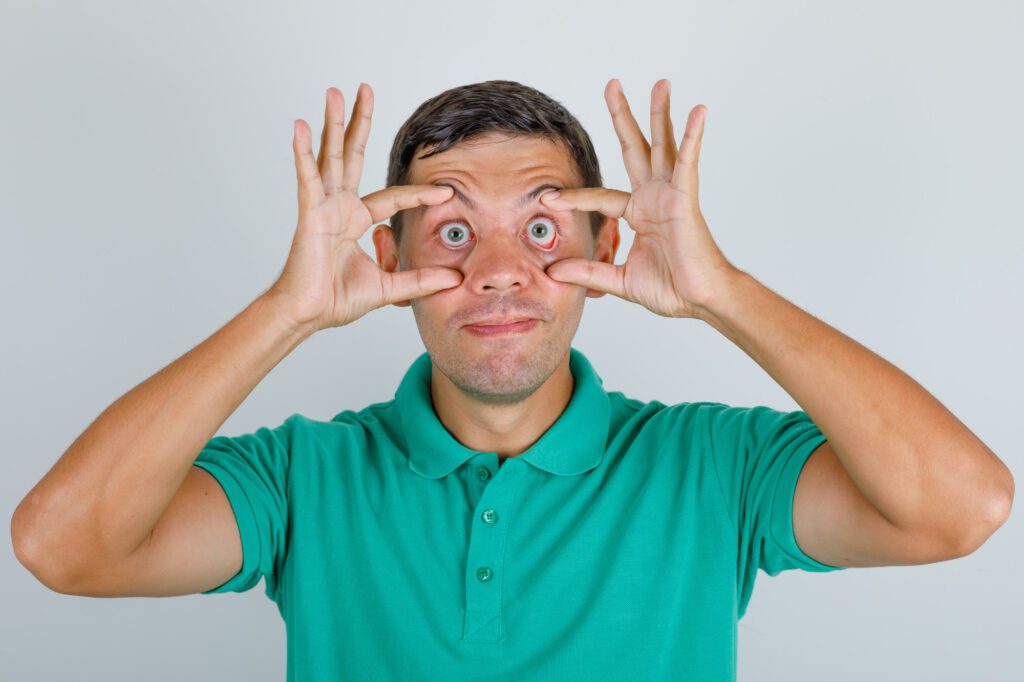Here, we are sharing information on the topic “6 eye exercises for myopia.”To make sure that the two eyes function together as a unit, vision therapy, or eye exercise, can be helpful. There are some common ailments that could benefit from eye-strengthening exercises. These include closing one eye, eyestrain, headaches, and skipping lines or words while reading. Eye tracking (saccadic dysfunction), lazy eye (amblyopia), eye turn (strabismus), and eye teaming issues can all be treated with vision therapy (convergence insufficiency).

6 eye exercises for myopia
Exercises for lazy eyes have been demonstrated to be highly beneficial in treating this problem, especially in cases where it is detected early.
1. Palming
- A yogic eye technique called palming suggests releasing tension from the muscles surrounding the eyes to lessen eye strain.
- First, warm your hands by rubbing them together. Shut your eyes and cover each cheekbone with the palm of your hand. For five minutes, cover each eye with a cup of your hand and take deep breaths.
2. Blinking
- Our blink rate decreases as we use digital devices for extended periods of time. The eyes may become dry as a result, feeling grittier, sandy, and exhausted.
- The tear film can be restored by taking the time to deliberately blink. The act of blinking stimulates the lubricating secretions secreted by the oil glands located in the eyelids. Spreading the tears across the eyes also helps.
- One way to practice blinking is to close your eyes, wait two seconds, and then open them back up. For additional stimulation of the oil glands, the eyelids can be deliberately pinched firmly while the eyes are closed.
3. Pencil Push-Ups
- To teach the eyes to converge or move inside toward one another when gazing at a close object, pencil push-ups are a popular exercise.
- Put on your best near-vision correction and hold a pencil at arm’s length to perform a pencil push-up. Pay attention to the eraser’s tip. Make sure the letter on the eraser is readable by bringing it into focus.
- Now, steadily glide the pencil in the direction of your nose while maintaining a single, concentrated eraser or letter. Pull it away from the eyes once more once it has doubled in size. Repeat many times.
4. Close and Distant Focus
- Training your concentrating system to activate and relax appropriately can be accomplished by alternating between close and far attention.
- For fifteen seconds, keep your thumb ten inches away from your face. As an alternative, to better activate your concentrating mechanism, hold up an object that has a letter on it close to you.
- Once the fifteen seconds are over, move your attention to a target that is 20 feet (6 meters) distant and hold it there for another fifteen seconds. Go back to your thumb. Repeat many times.
5. Figure Eight
- It can be difficult for some people to track an item with their eyes. One can practice figure eights to help with this.
- Select a spot on the ground that is ten feet from you. Draw an imaginary figure of eight using your eyes. After 30 seconds, continue in the opposite direction.
6. 20-20-20 Guideline
- When performing close tasks with our eyes, our focusing system may get overworked. We can also experience dry eyes. Setting aside time for regular breaks might ease some of this stress.
- Remembering the 20-20-20 rule is simple. Take 20 seconds to focus on an object 20 feet away after every 20 minutes of near work. At this point, you can resume your nearby activity.

Frequently asked questions
(6 eye exercises for myopia)
Do eye exercises work for myopia?
Answer: Myths about myopia and shortsighted remedies for kids | Eye exercises to treat myopia: FALSE
However, studies have indicated that these do not affect children’s myopia reduction or the stability of their eyesight over time. According to one study, children and teenagers who engaged in these exercises on a daily basis had a higher likelihood of developing myopia or other visual impairments.
Is minus 2 eyesight bad?
Answer: The American Optometric Association (AOA) has established the following severity levels for nearsighted people: In the range of -0.25 to -2.00, your nearsightedness is light. In the range of -2.25 to -5.00, your nearsightedness is considered moderate.
How to reduce myopia?
Answer: Lifestyle Changes to Delay the Advancement of Myopia
Play in the daylight outside. According to research, children who spend more than 90 minutes outside each day slow down the myopia’s onset.
- Make effective use of the lighting.
- Children can avoid eyestrain by working in well-lit environments.
- Limit the amount of time you spend on screens.
- Introduce the 20-20-20 rule to children.
Conclusion
(6 eye exercises for myopia)
In conclusion, myopia exercises have drawn interest as possible treatments to reduce symptoms and maybe slow the advancement of nearsightedness. Scientific study on the usefulness of some workouts is still equivocal, despite anecdotal evidence suggesting that they may offer brief respite or increase visual clarity.
The 20-20-20 rule, near-far concentration, eye rotations, pencil push-ups, palming, and eye massage are six popular eye exercises for myopia. Usually, the goals of these exercises are to lessen eye strain, enhance concentration, and encourage muscular relaxation in the eyes.
So, this is how the topic “6 eye exercises for myopia” has been addressed.
- For more information related to these topics, click here.
- You may also visit our Instagram page by clicking here.
- You may also visit our YouTube channel by clicking here







 Levera 500
Levera 500